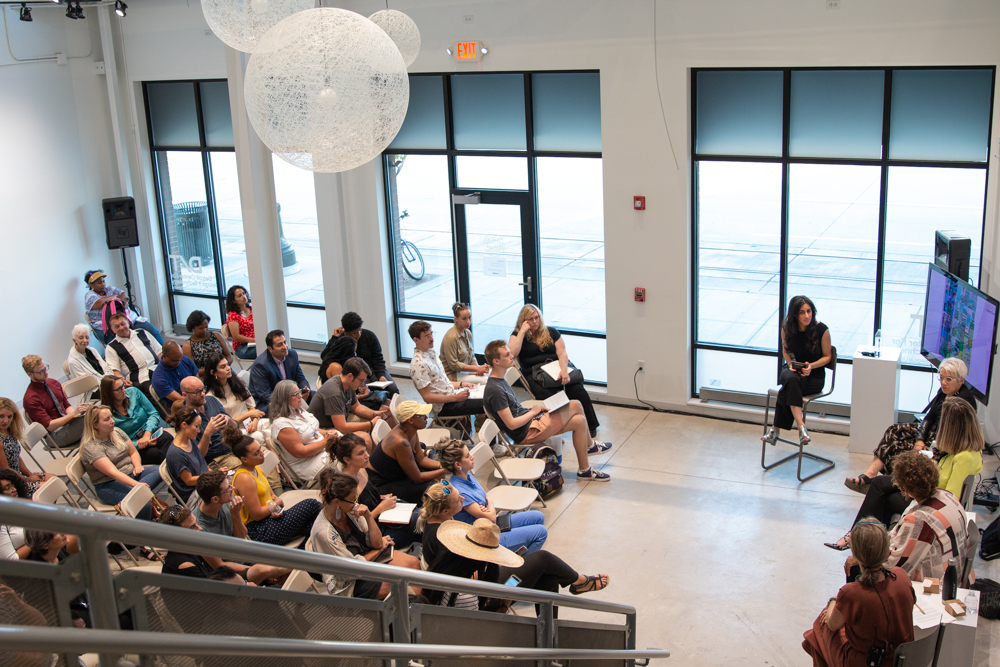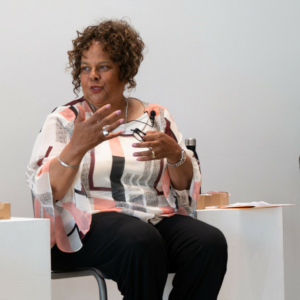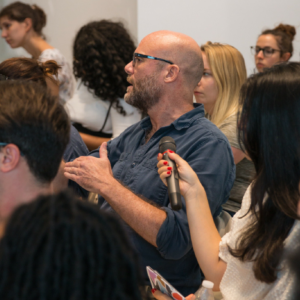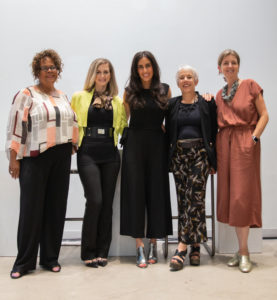In December 2015, Detroit was designated as the first and only UNESCO City of Design in the United States. To celebrate this designation, Design Core Detroit transitioned the Detroit Design Festival from a week-long series to Detroit Month of Design in September this year. Our third Blended panel, hosted by Blended Collective Founder Lydia Michael, was held in partnership with Detroit Month of Design at the LTU Detroit Center for Design + Technology on September 5, 2018, where we discussed the Intersection of Culture and Design.
Meet The Panelists (left to right)
- Felicia E. Molnar, Executive Director of Strategic Initiatives, Detroit Institute of Arts
- Reem Akkad, Founder and Interior Designer, Reem Akkad Design
- Karen Hudson Samuels, Executive Director, WGPR TV Historical Society
- Sally Erickson Wilson, Chair of MFA Color and Materials Design, College for Creative Studies
Our American culture is a blend of countless different cultures versus homogeneous countries, such as Italy, where culture is well-defined. What can we learn from homogeneous cultures, and how can we incorporate that into our daily lives?
Felicia E. Molnar – “I was traveling in Tokyo, Japan recently. They have a monoculture in some ways without a lot of impact from the West. They have strong control over every facet of life. There’s beauty in that, but also inflexibility. When there are multiple cultures, people must be more tolerant and learn to collaborate. This is similar to The Midtown Cultural District project we’re working on at the Detroit Institute of Arts (DIA). To create a vision for something new, we must wrestle with different cultures that are just assumed and try to transform those. If you can’t do that, change is difficult. The Japanese, for instance, don’t have to respond to a lot of outside influences and are successful in keeping their culture mono- and controlled.”
Karen Hudson Samuels – “We’re currently working on collaborative culture [as an American society]. Right now, understanding partnerships and collaborations is important. WGPR TV Historical Society was fortunate to partner with the Detroit Historical Museum when we did our first exhibit on the history of the station. This showed us that part of exploring culture is also understanding history.”
As we continue the revitalization of neighborhoods in Detroit, and as the designers throughout our community work with small businesses and residents to design or redesign spaces, do you have any practical advice for how to preserve cultural integrity?
Sally Erickson Wilson – “It’s essential that time is spent with the neighborhood to help them research and write a focused brief on the hierarchical values or foundation pillars in the area in order to be efficient with time. I use a phrase from a Ford executive that studied at INSEAD in France: Where are we? Where do we want to go? How do we get there? The most important one is Where are we? to discuss and agree as partners. From there on as a designer, 75% of your work is building trust and 25% is your content. If you don’t have trust, nobody is going to buy into your concept.”
Karen Hudson Samuels – “Having a seat at the table is important. Understanding whether there is a historical element that needs to be preserved is relevant. There are certain community groups you can tap into to find out more information and they’ll tell you everything you need to know.”
Reem Akkad– “It’s important to keep in mind that when you’re designing, you’re designing with and not for. You must make sure that people are an integral part of the process. I love what Habitat for Humanity does. They involve neighborhoods in the process when they’re redesigning, so people have a real stake into the end result.”
Sally and Felicia, what are the specific methodologies that your respective institutions use to examine culture?
Felicia E. Molnar – “Engaging as many stakeholders on as many levels as possible. Having conversations with your different audiences, colleagues and your cohort is the key to successful design and institutions.”
Sally Erickson Wilson – “The practice is that everything needs to be informed by research. We do primary (e.g. interviews, surveys) and secondary research (e.g. reading, academic papers, case studies, trend forecasting). So, engaging with a lot of databases for different cities.”
Is it possible to have an absence of culture in design? An example is suburban cookie-cutter homes. What’s the culture there?
Reem Akkad – “I think that those cookie-cutter homes are not actually an absence of culture, but rather that the culture has not been translated accurately. People were on a fast track and forgot to look at this multifaceted experience. It was probably more of a bottom-line decision and a result of limited resources, not only financially, but in terms of creativity and thought processes. But now online resources and mass exposure to diverse perspectives help enrich and diversify all environments. It boils down to the person initiating this prospect.”
Karen, how did design influence the cultural community here in Detroit when WGPR TV Historical Society was present?
“The goal was to reflect the local community and stories that weren’t being told on a regular basis. The newscast was also reporting about what was happening internationally, which was progressive at the time to Detroiters and the African-American community.”
Felicia, can you tell us how you’re reshaping the arts and cultural district here in Detroit with your DIA Plaza Project?
“It began as a vision of our new director Salvador Salort-Pons wanting to create a public space on the front yard of the DIA. He comes from Madrid, so he wanted to create a plaza for people to gather. We received some planning money from the National Endowment for the Arts and the William Davidson Foundation. As we started interviewing area stakeholders, we realized that this is a vision for the whole district. Many CEOs in the district wanted to figure out ways to connect their institutions to work more collaboratively, creating space for public programming. This project is transformative in terms of creating an opportunity for the district to reimagine itself.
Out of this vision launched a planning project featuring a design competition. We’ve had 44 submissions from world-renowned design firms, and three finalist teams have been selected by a locally and internationally respected jury of peers and landscape designers, like the curatorial director of the Smithsonian museum. The objective of the competition is to find the best design team to engage with our community and think of the questions about what the culture looks like to figure out a way forward. The public presentations will be held on January 23, 2019.”
Sally, what are your thoughts on the quote you shared by John Berger, author of The Art of Seeing: “The way we see things is affected by what we already know or believe.”
“The things I know frame the way I see things. But when teaching in the classroom, you ask yourself, how can I make the students see? As the daughter of an architect, I notice everything due to the environment I grew up in. Sometimes when you go from one environment to another, you see things that other people may have never noticed. It’s an ability to fine tune things. First of all, you need to understand your environment. There’s a course called blue taught by Jessica Helfand at Yale University. It’s essentially a treasure hunt to explore the culture and history of the color. We adapted this by having every student focus on a different color and create a collage of images with it.”
“If you see yourself and you can have a conversation with an object, isn’t that the sign of success in some way? There are no barriers. Everyone is welcome. Maybe that’s the pinnacle of great design.” – Felicia E. Molnar, Executive Director of Strategic Initiatives, Detroit Institute of Arts
Reem, what’s your opinion on cultural appropriation with one culture using the motives of another culture when it comes to residential design?
“It’s very specific to the client. It’s important to discover the client’s intention and integrate that into the environment. I don’t think cultural appropriation is a problem with specific homes, but it may be for larger scale like businesses. For a resident, it’s about creating refuge, using specific motives they can relate to, or that gives them comfort. It’s about creating a pleasurable experience for the client.”
Many people feel like they must leave Detroit in order to find authentic design inspiration. Do you find yourself appealing to that innovation to keep that audience here?
Felicia E. Molnar – “I don’t think it’s an either/or proposition. People shouldn’t have to feel like they must leave and never come back. I hope that they leave and bring back what they’ve learned because that’s how you get to be a great designer.”
What does the word blended mean to you?
Reem Akkad – “When thinking about the intersection of design and culture, I think of all of these translucent layers on top of each other coming together to form a final product that’s so much more than the sum of its parts. It’s so much richer and carries so much more tradition and variation than each layer would have if it were to stand on its own. It’s important to harness all of this for everybody who experiences a space.”
Felicia E. Molnar – “The ultimate utopian vision of diversity would be an extremely blended culture with high tolerance for lots of different expressions of our differences. The differences don’t have to be erased, but understanding how they can exist and have a certain identity.”
This event about The Intersection of Culture and Design on Wednesday, September 5, 2018 was part of our quarterly speaker event series. Thank you to our sponsors: LTU Detroit Center for Design + Technology, Display Group, Pete’s Chocolate and Shot Selection.
Stay tuned on more details for our next Blended panel. In the meantime, let’s keep the conversation going! Share your thoughts on Instagram, Facebook or Twitter using our hashtag #BlendedCollective.
© Haintso Rakouth Photography for Blended Collective









